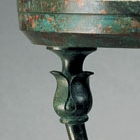J.J. Lally & Co., Oriental Art / New York City, New York
MenuPast Exhibition
Arts of Ancient China
March 27 - April 12, 2006
17.
AN ARCHAIC BRONZE LAMP
Han Dynasty (206 B.C. - A.D. 220)
with solid columnar standard rising from a wide circular base to a rounded knop surmounted by a stylized open flower emerging from a cluster of three large symmetrical petal motifs surrounded by three slender arms curving out and up to three buds formed by matching clusters of three petals and rising stems supporting a wide ring with deep channel to receive the oil and with three short prickets for the wicks, the surface showing a smooth gray-green patina with brighter green areas of corrosion widely scattered overall.
Height 12 1⁄2 inches (31.7 cm)
The branched foliate design of this lamp is unusual. Most Han bronze lamps of this type follow a less elaborate design with a single pricket in a shallow dish raised on a central standard.
Compare the related bronze lamp stand, excavated in 1968 from the tomb of prince Liu Sheng, (died 113 B.C.), discovered at Mancheng, Lingshan, Hebei province, illustrated in Treasures from Hebei Provincial Museum, Beijing, 1999, no. 28.
Compare also the larger bronze lamp of similar form, dated by inscription to the 4th year of Yuanyan reign of Western Han dynasty (9 B.C.), in the collection of the Nanjing University, illustrated in Treasures from Nanjing University, Beijing, 2002, no. 43, p. 26.
For a survey of the subject of bronze lamps in ancient China, see the article entitled Zhanguo Qin Han de deng ji youguan wenti (Issues Regarding Lamps of the Warring States, Qin and Han) by Ye Xiaoyan in Wenwu, 1983, No. 7, pp. 78-86.
漢 豆形銅燈 高 31. 7 厘米
